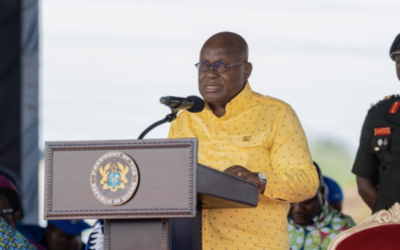It is an undeniable fact that, most countries around the world, especially majority of African countries have largely and predominantly blamed the War in Ukraine as the major cause of their respective economic crisis.
However, according to the Data and Facts available, it seems the Economy of Ukraine is recovering fast and doing better than most African countries whose leaders have been constantly citing Russia invasion of Ukraine as one of the major reasons for economic setbacks in their respective Countries.
The war in Ukraine from the beginning disrupted the global supply chain systems but some countries have been able to adopt pragmatic solutions to handle the supply chain crisis caused by the invasion of Ukraine by Russia.
Regardless of the ongoing war in Ukraine, the Government of Ukraine, business community and generally, the Ukrainian citizens have started experiencing some considerable level of economic recovery to the extent that the Citizens who were displaced as a result of Russia’s invasion are coming back to Ukraine.
Currently, some of the economic indicators are improving in Ukraine:
- The inflation rate of Ukraine for the month of March 2023 was 21.3% better than most Countries which are not at war.
The inflation rate was 24.9% in the month of February 2023.
- The Ukrainian Currency, Hryvnia(UAH) is also picking up, doing better than most countries which are not at War.
-
S&P Global ratings, Moody’s ratings and Fitch have rated Ukraine as CCC, Ca and CC respectively, at least better than most countries which are not at War.
-
Many experts including IMF and World Bank projectd that, the economic output of Ukraine would plunge by between 40% and 50%, however, the economic output of Ukraine shrank by 30.4% in gross domestic product.
-
Ukraine is still in the Agriculture business of exporting grains and other commodities through Black Sea and this was made possible by a breakthrough arrangement with Russia and Turkey.
-
The Executive Board of the International Monetary Fund(IMF) has recently approved and officially announced a US$ 15.6 Billion under a new Extended Fund Facility(EFF) arrangement for Ukraine as part of the US$ 115 Billion overall support package.
-
The National Bank of Ukraine(NBU) at its meeting on 16th March 2023 maintained the Policy Rate for Ukraine at 25%.
This 25% Policy Rate is far better than the Policy Rates for most Countries which are not at War.
- Effective 7th April 2023, the National Bank of Ukraine(NBU) introduced three-month Certificates of Deposit with a fixed equal Rate to the Policy Rate as well as cut Interest Rates on overnight certificates of Deposit to 20%.
-
Effective 11th May 2023, the National Bank of Ukraine(NBU) has indicated that, preferential reserve requirement ratios for Deposits will only apply to Deposits maturing in more than 3 months.
-
Largely due to the continuous invasion of Ukraine by Russia and cost of military operations, the national debt of Ukraine has reached a peak of around $161.94 billion.
Government Debt to GDP Ratio was 78.4% in 2022. However, the State Debt to GDP Ratio in 2022 was 71.6%, an increase from 43.3% in 2021.
The increase in public debt was due to the 50.4% increase in debt received on preferential terms, from $29.1 billion in 2021 to $43.9billion in 2022.
According to the IMF’s Exended Fund Facility(EFF) Programme, Ukraine’s public debt could reach 81.7% of GDP in 2022, 98.3% of GDP in 2023 and it could peak at 105% of GDP in 2024, after which it will begin to gradually decline.
This is Ukraine, a Country that has been receiving bombing every day yet its Debt to GDP Ratio is far better than most Countries which are not to War.
- According to the Ministry of Finance for Ukraine, payments on Ukraine’s National Debt in 2023 will amount to $18 billion(at the current exchange rate is equivalent to UAH 658.4 billion) while those on foreign debt will stand at a mere $3.3 billion(equivalent to UAH 122.4 billion). Also $771.1million will be spend on Debt servicing and $2.6 billion on principal debts.
Interestingly, the Ukrainian State Budget in January 2023 reduced to a deficit of $1.9 billion according to the Finance Ministry of Ukraine, supported by a Reference Data from the State Treasury Service of Ukraine.
In January 2023, the General Fund of the State Budget received $2.8 billion. Out of this amount, 64.3% was generated domestically and the remaining $1 billion(35.7%) was received in the form of International grants(aids).
The question is, Countries which are not at War, how much are their respective national debts?, and how much are they paying to service these debts?
In addition to aforementioned economic success of Ukraine, domestically, the Ukrainian Government has been able to put the following measures in place to sustain the smooth running of the economy of Ukraine regardless of the ongoing invasion by Russia:
- The financial infrastructure of Ukraine has remained solid and intact, allowing citizens and the business community to transact businesses,make payments and receive payments without any form of difficulties.
The banking and the financial systems have been very strong and operational with no functional limitations. All the banks/financial institutions are fully operational in Ukraine.
- Outflow of Cash or Capital has been stopped by the Government. This will prevent exchange rates pressure on the national currency of Ukraine.
-
The Government in addition to blocking outflow of capital has also implemented a robust Fixed Exchange Rate Regime.
-
In addition to the International assistance, the Government has created new sectors of the economy to solely finance and support the Armed Forces of Ukraine.
-
To prevent Ukrainians from suffering from cold, darkness as well as securing the banking network, the Ukraine Government has implemented a POWER BANK. “This involves the creation of ONE NETWORK of branches of systematically important banks in Ukraine”. Operational solutions have also been designed to provide support to the One Network and this is functional throughout even under blackout conditions, there will still be availability of electricity, internet connectivity and cash across the Country.
-
The Ukraine Government has further created Special Energy Stations across the country where citizens can go there to charge their machines/phones, receive hot meals and get warm when there is no electricity. Banking services are also available in these Special Energy Stations.
While most African countries are blaming Russia-Ukraine War for their respective economic crisis, Ukraine too is busy thinking outside the box beyond the help of IMF, USA, UK and others to improve the country’s economy.
Constantly blaming Russia-Ukraine war and COVID-19 are not good enough to convince the suffering masses. Domestically, there are alot of measures African Governments can implement to offer turnaround solutions to the socioeconomic challenges of their respective countries.













